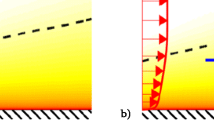Abstract
The results of an experimental investigation of the mechanism of reducing surface friction by mounting thin plates — large-eddy break-up devices (LEBUs) — in a turbulent boundary layer parallel to the surface are given. The conditions under which the surface friction reduction is minimal are determined. It is shown that the presence of LEBUs in the turbulent boundary layer leads to a decrease in the frequency of decelerated-fluid ejection from the wall region into the outer region of the boundary layer.
Similar content being viewed by others
References
A. M. Savill and J. C. Mumford, “Manipulation of turbulent boundary layer by outer-layer devices: skin-friction and flow-visualization results,”J. Fluid Mech.,191, 389 (1988).
J. B. Anders, “Outer-layer manipulators for turbulent drag reduction,” in:Viscous Drag Reduction in Boundary Layers, Progress in Astronaut. and Aeronaut.,123, 263 (1990).
F. H. Clauser, “Turbulent boundary layers in adverse pressure gradients,”J. Aeronaut. Sci.,21, No. 2, 91 (1954).
E. U. Repik, V. K. Kuzenkov, and N. P. Mikhailova, “Effect of the velocity gradient and the proximity of a wall on the readings of a Pitot tube used to measure the surface friction and velocity distribution in a turbulent boundary layer,”Inzh.-Fiz. Zh.,48, 895 (1985).
S. J. Kline and P. W. Runstadler, “Some preliminary results of visual studies of the flow model of the wall layers of the turbulent boundary layer,”Trans. ASME, Ser. E, J. Appl. Mech.,26, No. 2, 166 (1959).
E. U. Repik and Yu. P. Sosedko, “Investigation of the discontinuous flow structure in the wall region of a turbulent boundary layer,” in:Turbulent Flows [in Russian], Nauka, Moscow (1974), p. 172.
E. U. Repik and Yu. P. Sosedko, “Spectral investigation of a quasi-ordered flow structure in a turbulent boundary layer,”Izv. Akad. Nauk SSSR, Mekh. Zhidk. Gaza, No. 3, 10 (1982).
J. R. Offen and S. J. Kline, “A proposed model of the bursting process in turbulent boundary layers,”J. Fluid Mech.,70, 209 (1975).
A. C. M. Beljaars and Krishna K. Prasad, “A model for periodic structures in turbulent boundary layers,”Lecture Notes Phys., No. 136, 93 (1981).
Additional information
Moscow. Translated from Izvestiya Rossiiskoi Akademii Nauk, Mekhanika Zhidkosti i Gaza, No. 5, pp. 80–89, September–October, 1996.
Rights and permissions
About this article
Cite this article
Kuzenkov, V.K., Levitskii, V.N., Repik, E.U. et al. Investigation of the mechanism of surface turbulent friction reduction by means of large-eddy breakup devices. Fluid Dyn 31, 694–701 (1996). https://doi.org/10.1007/BF02078221
Received:
Issue Date:
DOI: https://doi.org/10.1007/BF02078221



